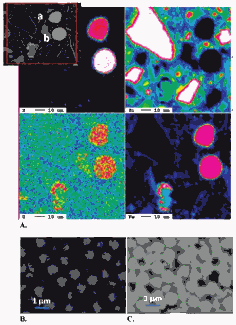A recently published Pacific Northwest National Laboratory study of a naturally bioreduced sediment sample from a former uranium mill tailings site reveals insights that enhance understanding of the long-term persistence of uranium in groundwater. The study provides the first-ever evidence of a useful pyrite mineral formation within the sample.
This mineral form is called "framboidal" because its surface resembles a framboise (French for raspberry). The study presents data showing that framboidal pyrite has an affinity for uranium, decreasing its transport via groundwater. The sample originated from a U.S. Department of Energy Integrated Field Research Challenge site at Rifle, Colorado.
X-ray spectroscopic analyses conducted at the Materials Research Collasborative Access Team 10-ID beamline at the U.S. Department of Energy’s Advanced Photon Source at Argonne National Laboratory confirmed that framboidal pyrite uranium occurred in both oxidized and reduced forms. This is important because the mobility of contaminant uranium depends strongly on its valence state: reduced uranium is usually much less mobile.
This new understanding will help in developing strategies for keeping the contaminant out of aquifers and away from humans, animals and crops.
This research showed that framboidal pyrite may initially serve as a "sink" for uranium, where the contaminant may be sequestered under reducing conditions. Framboidal pyrites may also serve as long-term sources of contaminant uranium under conditions of slow oxidation. More studies are planned to better understand the reduction and the oxidation processes in the naturally bioreduced sediment. Clearly not all pyrites, framboidal or otherwise, contain high uranium, so understanding what controls uranium uptake in pyrite is a crucial next step.
© PhysOrg.com 2003-2009
More information: N. Qafoku, R.K. Kukkadapu, J.P. McKinley, B.W. Arey, S.D. Kelly, C.M. Wang, C.T. Resch, and P.E. Long, "Uranium in framboidal pyrite from a naturally bioreduced alluvial sediment." Environmental Science & Technology 43(22), 8528 (2009). doi:10.1021/es9017333

